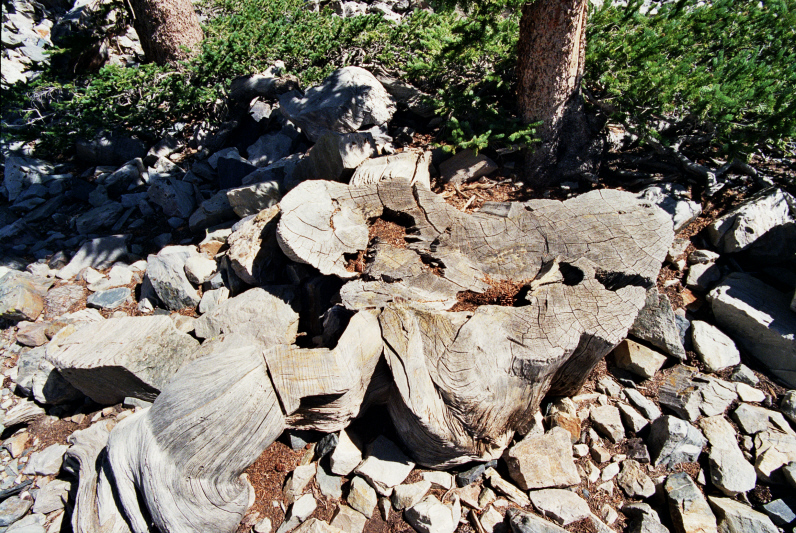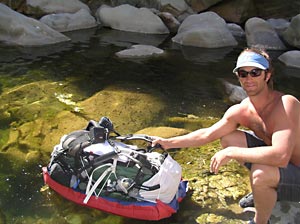 I thought I’d pass along this story of self-interest surpassing nature. It has all the themes with which we have become familiar: scientists who are so eager to publish they miss the point, park rangers who abandon their mundane stewardship role in favor of a little excitement, consequences no one had the foresight to imagine, and a scrambling finger-pointing afterwards.
I thought I’d pass along this story of self-interest surpassing nature. It has all the themes with which we have become familiar: scientists who are so eager to publish they miss the point, park rangers who abandon their mundane stewardship role in favor of a little excitement, consequences no one had the foresight to imagine, and a scrambling finger-pointing afterwards.
This is a bristlecone pine.
These trees grow on the Nevada border and are considered the oldest living things on earth. They are gnarled and windswept and battered by the ages. They stood during the Civil war, the War for Independence, the War of The Roses, and the Crusades. They were here for the birth of Christ, the Bronze Age and some of them have been here since the construction of the pyramids in Egypt.
They’ve been here a long time.
So in 1963 a plucky graduate student from North Carolina Chapel Hill University was interested in using the dendrochronological record of these trees to study climate conditions during the period known as the ‘little ice age’. (Just 600 years ago.) And he got a grant for a special tool to bore into trees and take a sample that would allow him to bring it back to the lab and count rings identifying dry years and wet years etc. Donald Rusk Currey, Ph.D. (1934 – June 6, 2004). He came across a particular stand of bristlecones in the snake range on Wheeler peak in particular. He thought these would be an ideal location to use his new tool (an 8 inch borer from Sweden) to begin his sampling. A particular specimen he had his eye on he called affectionately WPN-114
The story gets bifurcated here, but in most tellings he couldn’t get his sample (the core broke, the tree was too deep, etc) so he went to the local rangers and bemoaned his fate, and they said no problem! We’ll help you cut down the tree. (Read that again: No Problem! We’ll help you cut down that tree!!!) So they brought out the chain saw(s), cut and cut and eventually felled the tree. It was hard and took a long time to do. Then they gave him a nice slab to study.
(There is a stunning radio piece on this story by Radio Lab. The tree story starts around 14:30.)
So back at the lab, Currey patiently starts counting the rings: 2000, 3000, 4000, and when he gets to 4600 he starts counting again because he’s starting to realize something truly awful. Not only was this tree from the oldest trees in the world, it’s THE oldest tree. The oldest one that’s ever been counted. Not only the oldest tree. It’s older than any living thing on the entire planet. It’s THE oldest thing on earth. And he killed it.
It took a while for the story to percolate through the community, but eventually people were pretty shocked and furious by this. Fingers started pointing and Currey claimed that the rangers had offered and the rangers said that he had begged and no one knew who authorized it and everyone was upset. Currey spoke about the incident only once on camera, and then slipped quietly into the sunset in another field. It remains the thing in his life he was most (in)famous for.
When I hear a story like this, I like to play a little game, called “Who should have known better?” Certainly Currey, since the tree was obviously thousands of years older than the period he was trying to study in the first place. Definitely the Park Rangers, who should have had drilled into their head that the land they’re entrusted with protecting is more important than any researcher, politician or movie mogul. Of course no one could have known this was the oldest tree, but they knew it was OLD, and they all knew it was one of the reasons the park was there in the first place. From the highest rank who signed the paper to the lowest grunt that filled up the chainsaw, these folks knew better.
So when you wonder how the National parks and State parks can take such foolish action with beavers, just remember the story of Prometheus.
Prometheus (tree), a Great Basin Bristlecone Pine (Pinus longaeva) : The cut stump of the tree. Photo by James R Bouldin.












































